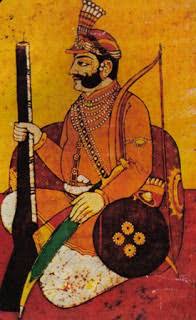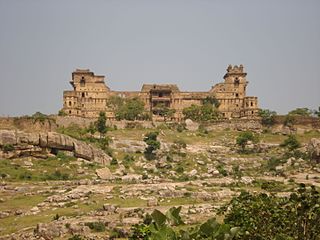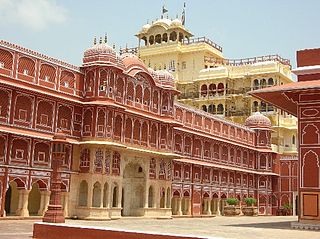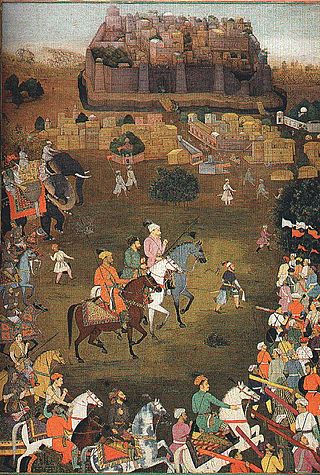

The Bundela is a Rajput clan. [2] [3] [4] Over several generations, the cadet lineages of Bundela Rajputs founded several states in area what came to be known as Bundelkhand anciently known as Chedi Kingdom from the 16th century. [5] [6]


The Bundela is a Rajput clan. [2] [3] [4] Over several generations, the cadet lineages of Bundela Rajputs founded several states in area what came to be known as Bundelkhand anciently known as Chedi Kingdom from the 16th century. [5] [6]
As per Jaswant Lal Mehta, the word "Bundela" is based on a deity, named Bind-bhasini Devi, who is believed to have her abode on the Bindhachal, the northern most part of the Vindhya ranges. [7]
According to Bundela legends, Jagdas' descendant Arjunpal was the ruler of Mahoni. His eldest son Birpal succeeded him as the king of Mahoni, although his younger son Sohanpal was the best warrior. To get his share of the kingdom, Sohanpal sought help from Naga (alias Hurmat Singh), the Khangar ruler of Kurar (Kundar). Naga demanded a matrimonial alliance in return. When Sohanpal refused, Naga tried to detain him and forcibly agree him to the condition. Sohanpal escaped, and unsuccessfully sought help from the Chauhans, the Salingars, and the Kachwahas. Ultimately, a Panwar chief named Panpal (or Punyapal) agreed to help him. Their joint army defeated Naga in 1288 CE. [8] Sohanpal killed all the Khangar men in the fort, but spared the babies on the condition that the Khangars would serve as the servants of the Bundelas. [9] Sohanpal became the king of Kurar, and his daughter married Panpal. [8]
Rudra Pratap Singh (reigned 1501-1531 CE), said to be a descendant of Sohanpal, moved his capital from Garh Kundar to Orchha in 1531 CE. [10] The Orchha State was the parent Bundela kingdom. Datia State (1626 CE) and Panna State (1657 CE) separated from the Orchha State. After the death of Panna's founder Chhatrasal in 1731, Ajaigarh State, Bijawar State and Charkhari State separated from Panna. [11] The official records of the Chhatarpur State also mentioned the clan of its rulers as "Panwar Bundela". Its founder was a Panwar, who was in service of the Bundela ruler of Panna State until 1785 CE. [11]
The Bundelkhand ("Bundela domain") region was named after the Bundelas. [12]
The different Bundela chieftains of Bundelkhand often fought against each other which the Mughals often took advantage of. [13]

Bajirao I, born as Visaji, was the 7th Peshwa of the Maratha Confederacy. During his 20-year tenure as a Peshwa, Baji Rao made efforts to establish Maratha dominance in the whole Indian subcontinent and fought the Mughals breathlessly for years. As a result, he was responsible for the Maratha raid on Delhi (1737) and also engaged In battles with the Portuguese.

Bundelkhand is a geographical and cultural region and a proposed state and also a mountain range in central & North India. The hilly region is now divided between the states of Uttar Pradesh and Madhya Pradesh, with the larger portion lying in the latter state.

Orchha is a town, near city of Niwari in Niwari district of Madhya Pradesh state, India. The town was established by a Bundela rajput ruler Rudra Pratap Singh some time after 1501, as the seat of an eponymous former princely state of covering parts of central & north India, in the Bundelkhand region. Orchha lies on the Betwa River, 80 km from Tikamgarh & 15 km from Jhansi in Uttar Pradesh.

Chhatri are semi-open, elevated, dome-shaped pavilions used as an element in Indo-Islamic architecture and Indian architecture. They are most commonly square, octagonal, and round. Originating as a canopy above tombs, they largely serve as decorative elements as opposed to functional elements. The earliest examples of chhatri being used in the Indian Subcontinent were found in the Shrine of Ibrahim in Bhadreswar, constructed between 1159 and 1175 AD.

Tikamgarh is a town and a tehsil in Tikamgarh district in the Indian state of Madhya Pradesh. The city serves as a district headquarters. The earlier name of Tikamgarh was Tehri consisting of three hamlets, forming a rough triangle. In Tikamgarh town there is locality still known as 'Purani Tehri'. Until Indian independence in 1947, Tikamgarh, formerly called Tehri, was part of the kingdom of Orchha, which was founded in the 16th century by the Bundeli chief Rudra Pratap Singh, who became the first King of Orchha. In 1783 the capital of the state was moved to Tehri, about 40 miles (64 km) south of Orchha, which was home to the fort of Tikamgarh, and the town eventually took the name of the fort. The district is famous for the old fort of Kundar known as Garh Kundar, which was built by Khangars and remained the capital of Khangar rulers from 1180 to 1347.

Datia District is in Gwalior Division in the Indian state of Madhya Pradesh. The town of Datia is its district headquarters.
Bijawar is a city the state of Madhya Pradesh, India. It is the administrative headquarters of Bijawar Taluk, and was formerly the capital of a princely state of British India of the same name. The people of Bijawar are demanding the district status from their state government. It is the 53rd proposed district of Madhya Pradesh

Chhatrasal Bundela was the Raja of Panna from 1675 to 1731. He is well known for his Resistance against the Mughal Empire.

The Khangar community are an Indian community. They are referred to by many other names, such as Khangaar, Khungar, Khengar, Khagar, Khangdhar and Rao Khangad.

Garh Kundar is a small village in the city of Tikamgarh, Niwari district of Madhya Pradesh. It has been named so after the splendid fort, or "Garh", of Kundar located here. From 925 to 1507 AD, Garh Kundar fort witnessed many battles and bloodshed. Yashovarma Chandel built the fort after conquering south western Bundelkhand. In the battle between Prithviraj Chauhan and the Chandels in 1182 AD fort commander. Shayaji Parmar lost and the fort came under Prithviraj Chauhan. Then Rajput King Prithviraj Chauhan appointed Khetsingh Khangar as the ruler of this fort who founded the Khangar Dynasty afterwards.
The Maratha–Mysore Wars were a series of conflicts in 18th century India between the Maratha Empire and the Kingdom of Mysore. Though initial hostilities between the sides started in 1770s, the last battle began on February 1785 and ended in 1787.

Orchha State was a kingdom situated in the Bundelkhand region and later a princely state in British India. The state was ruled by Bundela clan of Rajputs. It was located within what is now the state of Madhya Pradesh.

Vir Singh Deo, also known as Bir Singh Dev, was a Bundela Rajput chief and the ruler of the kingdom of Orchha. He was a vassal of the Mughal Empire. and ruled between 1605 and either 1626 or 1627. Vir Singh Deo assassinated Abul Fazl who was returning from Deccan in a plot contrived by the Mughal Prince Salim. He is also credited to have built the Jhansi Fort.

Khaniadhana or Khaniyadhana was a princely state of British India ruled by the Judev dynasty of Bundela Rajputs. The capital of the State was Khaniadhana. It was part of the Bundelkhand Agency and later the Central India Agency.

Jhujhar Singh was a Raja of the Orchha region in India during the 17th century.

Kusum Sarovar is a sacred water reservoir with a historic sand monument in its backdrop. It is situated on the holy Govardhan Hill between Manasi Ganga and Radha Kund in Mathura district of Uttar Pradesh, India. Kusum Sarovar is considered one of the sacred spots that witnessed the pastimes of Hindu deities Radha and Krishna. It is also the place of Jat ruler Maharaja Suraj Mal's memorial chhatri. Kusum Sarovar has Narada Kund, where Bhakti Sutra verses were written by Narada and the Shri Radha Vana Bihari Temple in the vicinity.

Rajput architecture is an architectural style notable for the forts and palaces of the many Rajput rulers, which are popular tourist attractions, many of the Rajput forts are UNESCO World Heritage Site.
After the mid-16th century, many Rajput rulers formed close ties with the Mughal emperors and served them in various capacities. It was because of the Rajputs that Akbar was not able to make complete Mughal Empire in India. The Rajput nobles had their daughters married to the Mughal emperors and their princes and also Mughals married there daughter to Rajput kings for political purposes. For example, Akbar performed 40 marriages for himself and for his sons and grandsons, of which 17 were Rajput-Mughal alliances. The successors of the Mughal emperor Akbar, the mothers of his son Jahangir and grandson Shah Jahan were Rajputs. The Sisodia Rajput family of Mewar made it an honor not to enter into matrimonial relations with the Mughals, and thus stood in contrast to all other Rajput clans. After this time, the marital relations between the Rajputs and the Mughals declined somewhat. Akbar's relations with the Rajputs began when he returned in 1561 from a visit by the Chisti Sufi Shaikh of Sikri, west of Agra. Then many Rajput princesses married Mughal emperor Akbar.

The Siege of Orchha was a military expedition of Mughal empire under Aurangzeb aganist rebellious Bundela Rajputs under Jhuhar Singh. The Mughal army captured the Bundela capital during the combined siege of Orchha, on October 4, 1635. Aurangzeb raised the Mughal flag on the highest terrace of the Jahangir Mahal and installed Devi Singh as the new administrator, while Jhujhar Singh escaped.
The Bundelas, who imparted their name to their habitat, were a clan of Rajputs, who emerged as a political entity in central India in the early medieval period.